Dark Branch Farm - Kenansville, North Carolina
Adam Grady says the enterprise mix on Dark Branch Farms hasn’t changed since the original case study was conducted in 2019, but has morphed into a more cohesive regenerative environment. Today, the Grady family’s primary focus is to get cover crops planted on all cropped acres, every year and they continue experimenting with different varieties and mix designs of cover crops to determine what works best within the ever-changing conditions. Adam says that this is both challenging and stimulating, because he must think about what he is doing before he does it.
Cover Crop Seed Enterprise
A couple of years ago, the Gradys began raising their own cover crop seed. Adam says they’ve been selling “a fair amount” of cover crop seed in multi-species mixes and when people ask how he mixes the blend, Adam replies, “With the combine,” because the cover crop varieties are planted together, harvested together, then run them through a seed cleaner to remove any chaff. Growing cover crop seed is a new enterprise that Adam and his family say is complementary to their other existing regenerative enterprises and he expects 2023 to be a banner year for his cover crop seed enterprise. He intends to continue to grow this enterprise further in the future.
Image Right: Adam, Brandy, Caden, and Anna Kaye
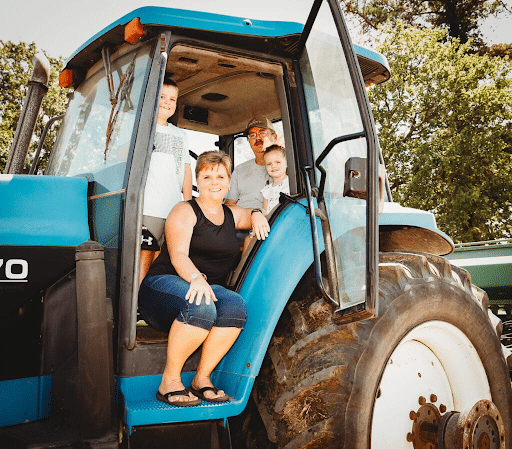
By producing his own cover crop seed, Adam is taking advantage of the power of epigenetics. The first Rule of Adaptive Stewardship, called the Rule of Compounding, states that there are no singular effects, that everything we do creates and fosters compounding and cascading effects, either positive or negative. Once we understand this, we can make better decisions. Epigenetics falls under the Rule of Compounding, creating compounding and cascading effects that can be either positive or negative. In his case, Adam produces powerful positive epigenetic effects in the plants he is growing by raising his cover crop seed from his biologically active soils and under his specific regional conditions. These epigenetic effects confer benefits that include better symbiosis with the native microbiology in the soil, stronger mycorrhizal associations, enhanced resilience in times of stress, and better performance overall. Since epigenetics are transgenerational, these positive compounding benefits will continue to grow and strengthen Adam’s soil and ecosystem health. By selling these cover crop mixes to his neighboring farmers, he also allows them to capture these same epigenetic benefits, so it becomes a powerful win-win situation and a sharing of regenerative success.
Adam reports that other farmers are showing interest in and strong demand for their cover crop seed, a very recent and positive development. When he and his family started their regenerative journey in the fall of 2016, his neighbors had no interest in planting cover crops. Adam was the lone adopter in his locale, and most farmers thought he and his family were “a little crazy for going regenerative.” His conventional farmer neighbors could not figure out why anyone would want to farm any other way.
However, by being both persistent and by demonstrating success, Adam’s neighbors (who had been watching from the shadows) slowly began to believe Adam was on to something. They were quite content letting Adam be the “guinea pig” on this new and “strange” way of doing things. Over the past several years, neighbors demonstrated increasing interest and began experimenting with regenerative practices like cover crops and no-till planting. Adam has become a key influencer and difference-maker in his community.
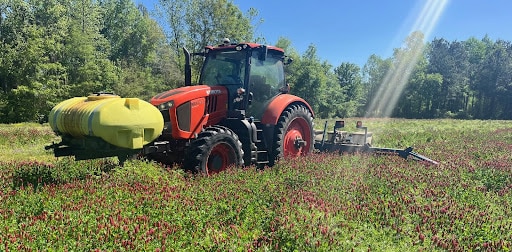
Planting the Next Cash Crop into Rolled Down Cover Crops
The Gradys consistently add new species to their cover crop mixes including black oats and Balansa Fixation clover. Adam has found that limiting the amount of brassicas (turnips, radishes, kales, etc.) in a mix is beneficial because they can quickly overpower other species in a mix and create issues. Adam says that too many seed companies, consultants, and Co-Ops recommend too much brassica in a mix. From a seed company standpoint, this can look impressive because brassicas tend to germinate quickly and grow vigorously and while that may seem attractive, it actually causes shading out of the other species in the mix and a high brassica component can skew the C:N ratio in the soil.
Many seed companies and consultants tell farmers that big tap rooted brassicas, such as tillage radishes and turnips, break up compaction layers in the soil but this is actually not accurate. They do leave big holes in the ground and act as nutrient reservoirs, but they do not relieve compaction. For relieving soil compaction, Adam instead recommends fine, fibrous rooted plants, such as the small grains.
Market Garden Enterprise
In 2022, Dark Branch Farms initiated a market garden enterprise. Adam planted strawberries as their primary crop and also produced cabbage, broccoli, kale, potatoes and new potatoes. The family constructed a simple roadside stand on a county road near their house and have been selling out of product every day. Most days, they sell out within 3-4 hours of opening the stand. Adam’s wife, Brandy, and their daughter, Anna Kaye, are primarily responsible for the roadside stand operations. Brandy, and other family members, want to expand the gardens dramatically, but Adam is a bit more cautious and feels they can maintain the strawberries at the current level and add other vegetable species to the mix.
Adam and Brandy expect business to grow rapidly and are planning to construct a larger facility. They have been able to sell all that they produce without frequenting Farmer’s Markets, and Adam feels they can be more productive and profitable on less land by selling at their roadside stand.
NOTE: The Grady’s are located in a very rural part of eastern North Carolina. The nearest town of Kenansville has a population of just 692 people. They are not near a major metropolitan area or heavily trafficked roads. Their experience demonstrates that even people in rural areas are seeking good food and fresh food and will pay for it.
Adam likes to use a combination of cover cropping and tarps to help control weed pressure and to protect the soil temperature and moisture, which gives him a several-week head start on marketing produce compared to area competitors. These early offerings create a loyal customer base.
The gardens are set up to harvest produce on an every-three-day rotation picking a third of each field every day, and starting the rotation over again on day four. They sell what they pick each day, and when they sell out, they close the stand down for the rest of the day. The majority of the produce is sold in two-quart containers.

Strawberries in the Two-Quart Containers
Adam admits that faster growth in the market garden enterprise will likely require additional investment. For example, a cooler sufficient to house all the produce and keep it fresh would require a minimum $20,000 investment. Another option to expand their market garden more rapidly is to hire a sales team to sell at area farmers’ markets, which could support Adam’s current strategy of generating more traffic at their roadside stand. As customer traffic grows and they boost production, they’ll sell more straight off the farm.
Strawberries, in two-quart containers, are a huge draw. At $5 each, containers of new red potatoes sold as quickly as they could load them. Cabbages, which Adam estimated cost $0.30 per head to grow, sell for $2 per head.
In 2023, Adam plans to move an equipment building near the market garden's roadside stand and install coolers and freezers so customers can readily access and purchase the farm's produce and meat products. He plans to convert about half of that building into a walk-in refrigerator to sell meats and proteins from the stand. While they sold a fair amount of meat in 2022, it was cumbersome since Brandy would have to leave the produce stand, go to the house, get the meat the customer wanted and bring it back. They expect meat and protein sales to jump if more products are readily accessible at the point of purchase.
Adam says they are trying to maintain a regenerative mindset and grow their produce using regenerative practices, but it can be challenging at times. The majority of vegetable and berry growers actually use fumigation of soils to kill potential pathogens. This is a widespread practice in the Central Valley of California, where soils are often fumigated between every vegetable crop but soil fumigation significantly harms or kills all of the beneficial microbes in the soil.
Adam’s nursery stock supplier refused to warranty the plants if they did not fumigate their soil. Strawberry plug plants cost Adam about $5,400 per acre. Without following the supplier’s guidelines, Adam would be assuming all that production risk on his own, so Adam had to get creative; he had to figure out a way to meet their criteria while maintaining his regenerative progress.
As much as he didn’t want to, he decided to initially plow the strawberry ground — the first time they had used the breaking plow since Adam was in high school. Then he installed tarp rows, into which he would plant the strawberry plugs. As soon as he finished laying the tarps, he broadcast cover crop seeds over the top, then used a leaf blower to blow the seed from the tarps to the bare ground between the furrows. This strategy enabled Adam to satisfy his supplier’s planting requirements while seeding a cover crop to minimize the damage to his soils through tillage.
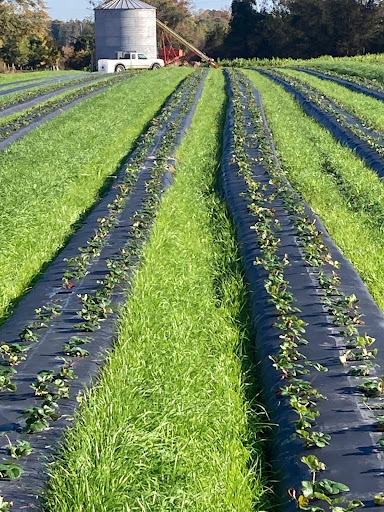
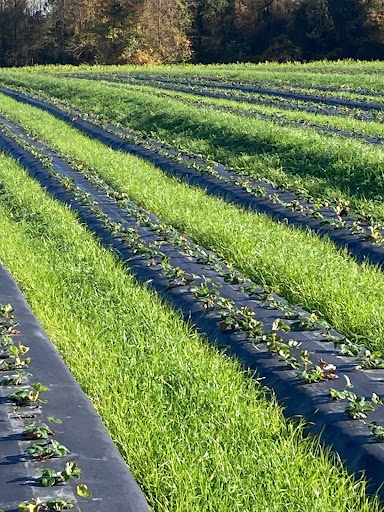
Adam’s Strawberries with Cover Crops Growing Between the Rows
Another strategy Adam uses to limit the damage from tillage is to use diverse crop rotations. He plants berries in different locations each year. As soon as they finish harvesting berries, Adam removes the tarps and plants a diverse summer cover crop mix of millets, sorghum Sudangrass, cowpeas and soybeans. He is able to harvest this cover crop as a baleage while maintaining ample cover to protect soil moisture and moderate soil temperature. Following the summer mix, he will often plant a mix of oats, rye, crimson clover, rape, daikon radish and turnips.
Healthy strawberries are the result of these practices. They have little disease and pest pressure and excellent fruit production.


Examples of Strawberries from Dark Branch Farms
Adam strategically plants brassicas in the fields where he plans to grow strawberries as a part of his total cover crop mix. The brassicas, particularly root brassicas like radishes and turnips, scavenge nutrients for storage in their tubers. At termination, as the tubers decay, they release gasses that naturally fumigate the soil, providing a strategy Adam uses to offset the need for synthetic fumigation, thereby minimizing its deleterious effects on soil biology while adding other plant species to support the soil biology.
Other Key Changes
One key change Adam has recently made in their farming operations is downsizing the total number of acres farmed. Instead he has re-focused on net-farm profits rather than total acres and maximizing yield. He now realizes that yield and net profit are not necessarily directly correlated.
One example of letting some land go is a previously leased 90-acre farm about 10 miles from the home farm. The landowners weren’t totally on board with the regenerative practices Adam was implementing and they did not understand the benefits. While Adam felt the lease price was fair for their area, the landlords seemed concerned only about the money with no consideration for the improvements to soil health. Adam decided it no longer fit their program and terminated the lease, essentially “firing” the landowner. Until that time, Adam had been farming about 1,100 acres and terminating that lease dropped the total down to about 1,000 acres.
Instead of adding acreage, the Gradys have shifted their emphasis to getting the most out of every acre. In a typical row crop situation, any one acre is in cash crop production for only 90-130 days of the year, leaving the soil bare and barren for two-thirds of the year. This approach does not help build soil organic matter, carbon or biology. By planting additional crops (such as cover crops) between the primary annual cash crop, Adam does a far better job of building overall soil health and enhancing ecosystem function.
Adam says they are searching for opportunities to grow cash crops in the spring and fall, with cover crops in between. The cash crops may be wheat or another small grain that they will harvest and take to the mill. Adam notes there is a difference between cover crops designed for forage and cover crops designed as cover crops. They are growing fall-seeded cover crops they plan to harvest and sell and grow forage cover crops that they harvest with livestock or with machinery as hay.
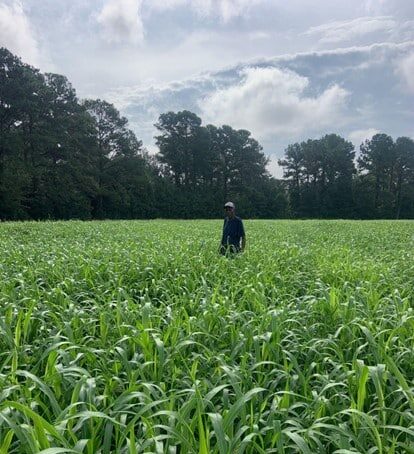
Cover Crop Field at Dark Branch Farms
Cover crops are great for supplemental grazing for cows and for grass finishing steers and heifers. However, Adam also likes to forage his pastured pigs and sheep on cover crops at certain periods of the year.
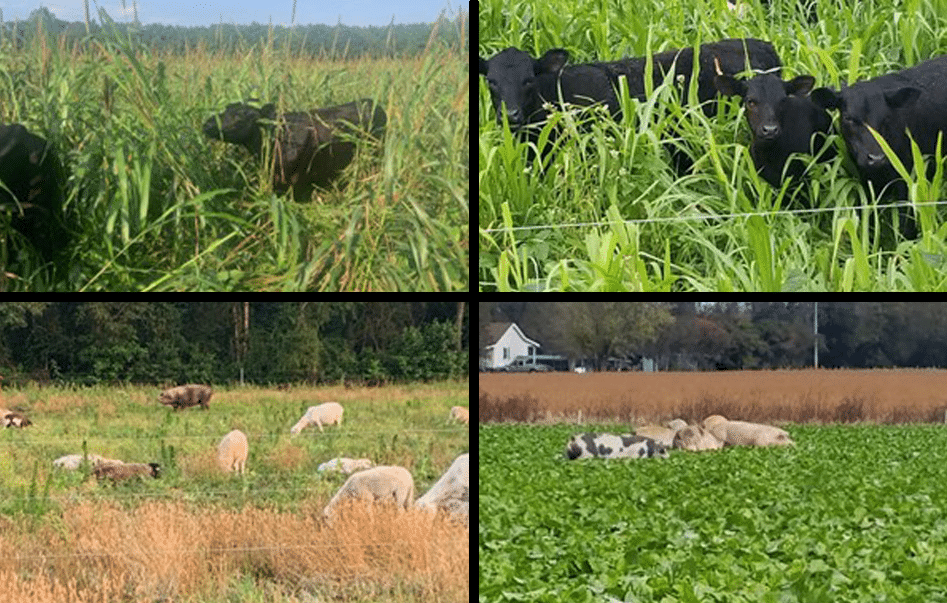
Livestock Grazing at Dark Branch Farms
Adam says that he agreed with Understanding Ag’s Allen Williams and Gabe Brown to give up his “tillage addiction” in exchange for continuing his hay-making and stored-forage business. He also admits that he has learned that dry hay is the most expensive source of sustenance for livestock and that it makes no sense for somebody to be doing that, but confesses he has a few other “bad habits, too.”
Dark Branch Farms still produces row crops, including non-GMO (genetically modified organism) corn. They successfully produced conventional soybeans for a couple of years but discovered there was no market they could access in their area that offered any type of price premium. The biggest issue they faced with soybeans was the production risk of herbicide spray drift from neighboring farmers. They had to plant Roundup Ready soybeans just to grow a crop and had two different 40-acre fields killed in 2022 from neighbors’ herbicide drift.
Herbicide drift is a growing problem with farmers who wish to farm regeneratively. With the planting of GMO crops specifically designed to have resistance to herbicides, drift from those herbicides travels much farther than the manufacturers want to admit (especially Dicamba), often when farmers and applicators spray when wind speeds are too high. So, farmers who plant non-GMO varieties of crops are immediately susceptible to the herbicides that their neighboring farmers use. There is often no legal recourse for these oversprays and drift, so regenerative farmers cannot recoup any financial losses.
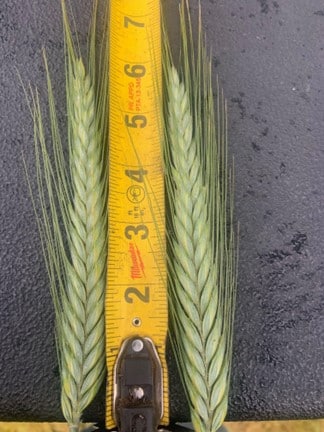
Example of Small Grains at Dark Branch Farms
Adam is planting more small grains as an alternative cash crop and to add diversity to his cash crop rotations. The quality of the grain is improving substantially as the soil health parameters improve. This represents potential unique marketing opportunities in the future as Adam could branch into marketing flours and meals produced from his home-grown grains. With an already established customer base with the produce and meats, Adam could easily expand into direct-to-consumer grain marketing.
By saving his own seed from conventionally grown cash crops and from the cover crops, Adam feels the epigenetic benefits are significant, that each crop is better than the preceding oneand with those improvements, they are building far greater resiliency. Initially, Adam thought the cover crop mix had to be in exact proportions, but he’s subsequently learned that the mix needn’t be that scientific, as long as they have at least three plant functional groups in each mix. There are four primary plant functional groups that most farmers deal with: grasses, legumes, broadleaves (forbs), and woody species.
As he continues to plant and harvest these multi-species cover crops, Adam believes natural selection and epigenetic effects will produce the best mixtures for his land. The timeframe to accomplish that through natural selection is what they are working through.
Area farmers are Adam’s primary customers for his cover crop seed. They see what he is doing and realize they don’t have the same advantages. For example, thanks to significantly improved soil water infiltration, Adam can get into his fields quickly after significant rains. Meanwhile, his neighbors are stuck at home, looking at the puddles and ponds of water in their fields, wondering how Adam can be out in his fields so soon. Adam says that while they may not understand the underlying reasons, they certainly see the practical, positive outcomes of his cover crops.
While farming fewer acres, Dark Branch Farms has focused on stacking enterprises in their operation. With the additional enterprises, Adam says they are not any less busy than they were five years ago but are more profitable and enjoy a much higher degree of success with what they do now.
Adam says they haven’t had to hire any additional farm workers compared to what they’ve used in recent years. They use the H2A program (featuring temporary, non-immigrant agricultural workers), which has proven to be their best source of responsible, reliable help in the area.
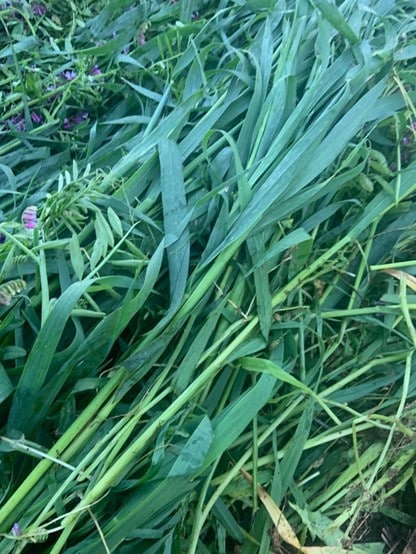
Closeup View of a Diverse Rolled Down Cover Crop Mix
THE TRANSITION TO REGENERATIVE PRODUCTION
Adam credits a friend as the key motivating factor behind his transition to regenerative agriculture. This friend challenged Adam to talk to Dr. Allen Williams from Understanding Ag, so Adam agreed and thanks to the resulting relationship, Adam believes he was able to transition into regenerative agriculture before he ended up in a situation that forced him into it as a last resort. He understands now that he was on a downward track to get to that point of last resort. After the initial sense of being pushed towards regenerative agriculture, it became more of a challenge, leaving Adam wondering, “Can I make this work?” After seeing the positive regenerative impacts on some of his small-acreage experiments, he was motivated to replicate those results on a larger scale in his operation.
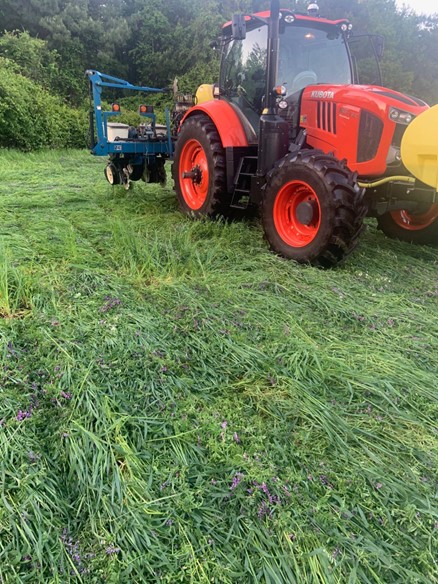
Rolled Down Cover Crop being Planted with a Cash Crop
Adam admits to initially being subjected to peer pressure. When he started down the regenerative path, he wondered how to produce regeneratively without everybody seeing his new strategies and thinking he was crazy. That quickly morphed into an “I don’t care who sees it” attitude and says he now relishes that many of his neighbors think he is crazy—“crazy like a fox.”
Adam is no longer figuring out how to apply the regenerative principles across the whole farm but instead focuses on what he can do to continue accelerating his progress. He doesn’t want to risk getting stagnant; instead, he remains focused on continually moving the “regenerative needle.” He values the work organizations like the Soil Health Academy and Understanding Ag do to help farmers and ranchers get started, particularly in helping him and other farmers make that significant initial progress. But he says at some point, individual farmers must take ownership and continue the progression themselves. “Anything I can do to help others in their transition process, to help them avoid two steps back for each step forward, that’s an opportunity to pay back what the Soil Health Academy and Understanding Ag have given me,” he says.
Does this mean that Adam, or other regenerative farmers, must continue their journey alone? Adam says the strong peer-to-peer relationships forged through his experiences with the Soil Health Academy and Understanding Ag mean he can always pick up the phone and call another regenerative farming peer or mentor to discuss issues he encounters. He still routinely talks with Allen, Gabe, and others.
When asked about key metrics that Adam considers when talking about “moving the regenerative needle,” he cited the adaptive regenerative practices in the farm’s strawberry enterprise. He says few experts would say it’s possible to incorporate tarp-use practices into a regenerative operation. While he admits his strawberry enterprise may not be what we would call “full-scale, no-till, regenerative,” his efforts are far better than no effort at all. Standard plastic tarp practices require fumigating the soil, which creates a growing medium devoid of life. When anything sprouts outside the plastic, conventional production uses herbicides to kill all other plant life. In contrast, Adam’s strategy protects and supports soil biology as he seeks natural practices to mitigate harmful pathogens while building beneficial microbial life.
When looking at seeding cover crops for grazing his livestock, Adam recommends a seeding rate from 100- 180 pounds per acre, depending on how intensely they intend to graze a given area. He knows of another farmer who recommends 25-50 pounds per acre, but he feels more is needed to address winter weed competition. One benefit of raising, harvesting, and cleaning their own seed is the lower cost to plant, even at a much higher seeding rate. Adam has not seen any lowered efficacy in the cover crop seed they grow versus what they purchased. Even if the germination rates were lower, the cost savings are such that they can boost their seeding rate and continue to save money.
For example, one season, he paid $50/acre for his cover crop seed. By harvesting his own cover crops for seed, Adam calculates he has $14/acre in the seed with a cost of $2/acre to clean the seed (equivalent costs on a per-acre basis), a total cost for the seed of $16/acre, resulting in a savings of $34/acre over the cost of purchased cover crop seed.
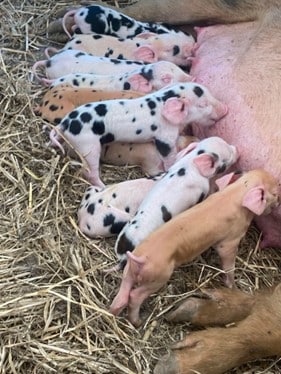
Adam has continued to expand their pastured pig business and sell to several branded pastured protein programs. In this farrow-to-finish program, Adam maintains a number of breeding stock and raises all his own pigs for finishing and harvest.
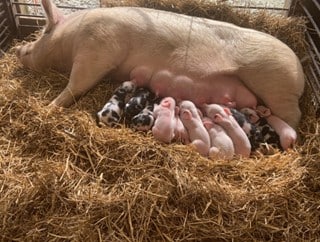
Newborn Piglets Nursing
When the newborn piglets are old enough to move around well, the sow and her piglets are moved to pasture from their bedded farrowing barn. They then stay on pasture until the pigs are ready to harvest.
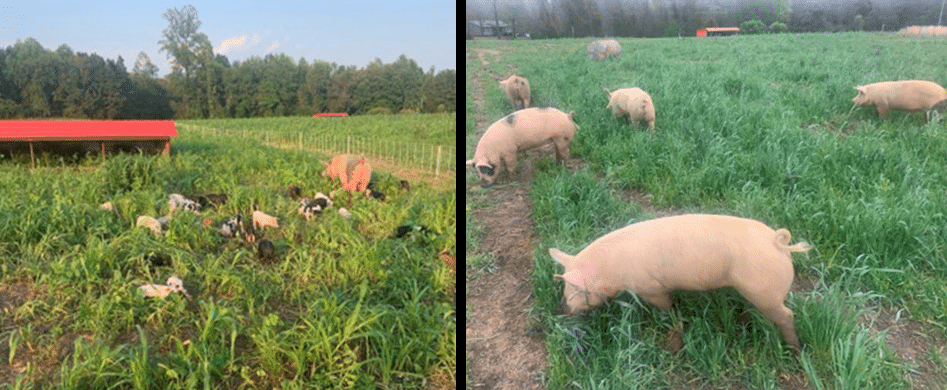
Mother and Babies Enjoying Their Pasture
Adam had expanded into pastured poultry production as well, buying newly hatched chicks and raising them out until harvest ready. They start their life at Adam’s farm in a brooder facility to protect them and keep them warm and when they are fully feathered, they are ready to go outside and spend their life on pasture.
Finishing Pigs on Pasture

Chicks in Their Brooder Until Ready to go out to Pasture
RECOMMENDATIONS FOR PRODUCERS CONSIDERING REGENERATIVE AGRICULTURE
For other farmers and ranchers considering transitioning from conventional production to regenerative farming, Adam advises being open-minded, even though many conventional farmers have production practices and philosophies are deeply ingrained and difficult to change. Adam says was there himself once and he only changed because he was willing to listen to new concepts.
Adam says that much of status quo agriculture in the U.S. is cemented in the current mindset of monoculture and commodity production, which results in overproduction and razor-thin producer profit margins. The false perception that higher yields per acre translate into higher net profit per acre perpetuates this producer mindset. Farmers hear the message every day to “Feed the world,” and that maximum crop yields are the way to accomplish this—and they grow up hearing their relatives and peers brag about yields. The pressure to seek higher yields is pervasive, and it is driving farmers to make the wrong decisions relative to their soil health practices and the financial health of their operations.
Farmers have so much at risk in conventional agriculture, yet the vast majority don’t know any other way to farm. “If we continue to do what we've always done, we can expect to get what we've always gotten, which is barely enough to survive,” Adam says. “No other profession takes the type of risk that we do every year.”
He says first-generation operators are at an advantage because although they may not know why they do what they do, it is easier for them to question tradition, and they’re more open to the changes required to make such a transition.
Adam stressed that operators of multigenerational operations must keep open minds. Learning the basics and continuously growing are key and he says he's taking steps to increase his awareness and education on regenerative production. The Soil Health Academy and Understanding Ag have been valuable resources. For Adam, Allen Williams is a go-to resource for help when he needs it.
There was a time when Adam, a Soil Health Academy graduate himself, thought the tuition for the school was astronomically high. He believed you couldn’t get farmers to attend unless you let them come for free. However, he soon realized that without personal investment, attendees would “pick and choose what they want out of it and only hear only what they want to hear and implement only part of the content.” Adam says those who don't intentionally implement all of the soil health principles, applying them as one, usually fail at their regenerative transition. Thus, SHA tuition represents an essential buy-in for the participants. Adam says to benefit fully from the course, “You have to have skin in the game.”
Ultimate Results
With the transition to regenerative agriculture, Adam not only realizes significantly better net profits per acre, but also reports a remarkable increase in beneficial insect populations, particularly pollinators and beneficial insects that prey on pests. He has observed a significant improvement in bird population numbers with an increase in the number of bird species present. Other wildlife species are exploding in numbers as well. He gave an example of a recent farm workshop he hosted where the presentations went late into the evening. During the presentations, workshop attendees noticed the insect activity, pointing out the buzzing and chirping. Adam noticed it, too, but he says to have outsiders do so confirmed the changes he has observed.
More net profits, higher quality of life, more beneficial life in the soil and above the soil are what drives Adam now. His switch to regenerative farming has also “flipped the switch” to greater stewardship as well.
